CHEVROLET PRIZM 1998 3.G Owners Manual
Manufacturer: CHEVROLET, Model Year: 1998, Model line: PRIZM, Model: CHEVROLET PRIZM 1998 3.GPages: 364, PDF Size: 18.79 MB
Page 91 of 364
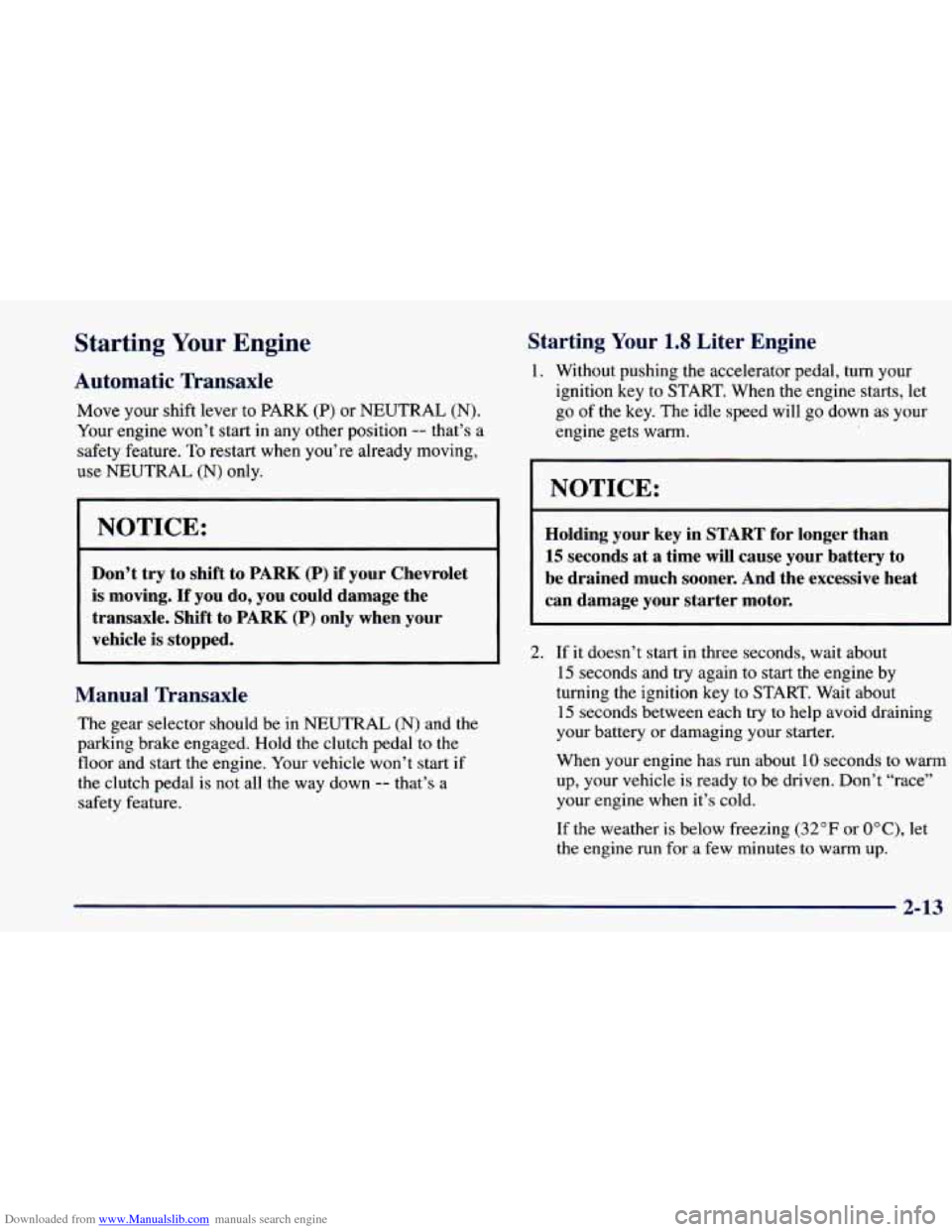
Downloaded from www.Manualslib.com manuals search engine Starting Your Engine
Automatic Transaxle
Move your shift lever to PARK (P) or NEUTRAL (N).
Your engine won’t start in any other position -- that’s a
safety feature. To restart when you’re already moving,
use NEUTRAL (N) only.
I NOTICE:
Don’t try to shift to PARK (P) if your Chevrolet
is moving. If you do, you could damage the
transaxle, Shift to PARK (P) only when your
vehicle is stopped.
Manual Transaxle
The gear selector should be in NEUTRAL (N) and the
parking brake engaged. Hold the clutch pedal to the
floor and start the engine. Your vehicle won’t start if
the clutch pedal is not all the way down
-- that’s a
safety feature.
Starting Your 1.8 Liter Engine
1. Without pushing the accelerator pedal, turn your
ignition key to START. When the engine starts, let
go
of the key. The idle speed will go down as your
engine gets warm.
NOTICE:
Holding your key in START for longer than
15 seconds at a time will cause your battery to
be drained much sooner. And the excessive heat
can damage your starter motor.
2. If it doesn’t start in three seconds, wait about
15 seconds and try again to start the engine by
turning the ignition key to START. Wait about
15 seconds between each try to help avoid draining
your battery
or damaging your starter.
When your engine has run about
10 seconds to warm
up, your vehicle is ready to be driven. Don’t “race”
your engine when it’s cold.
If the weather is below freezing (32” F or O’C), let
the engine
run for a few minutes to warm up.
2-13
Page 92 of 364
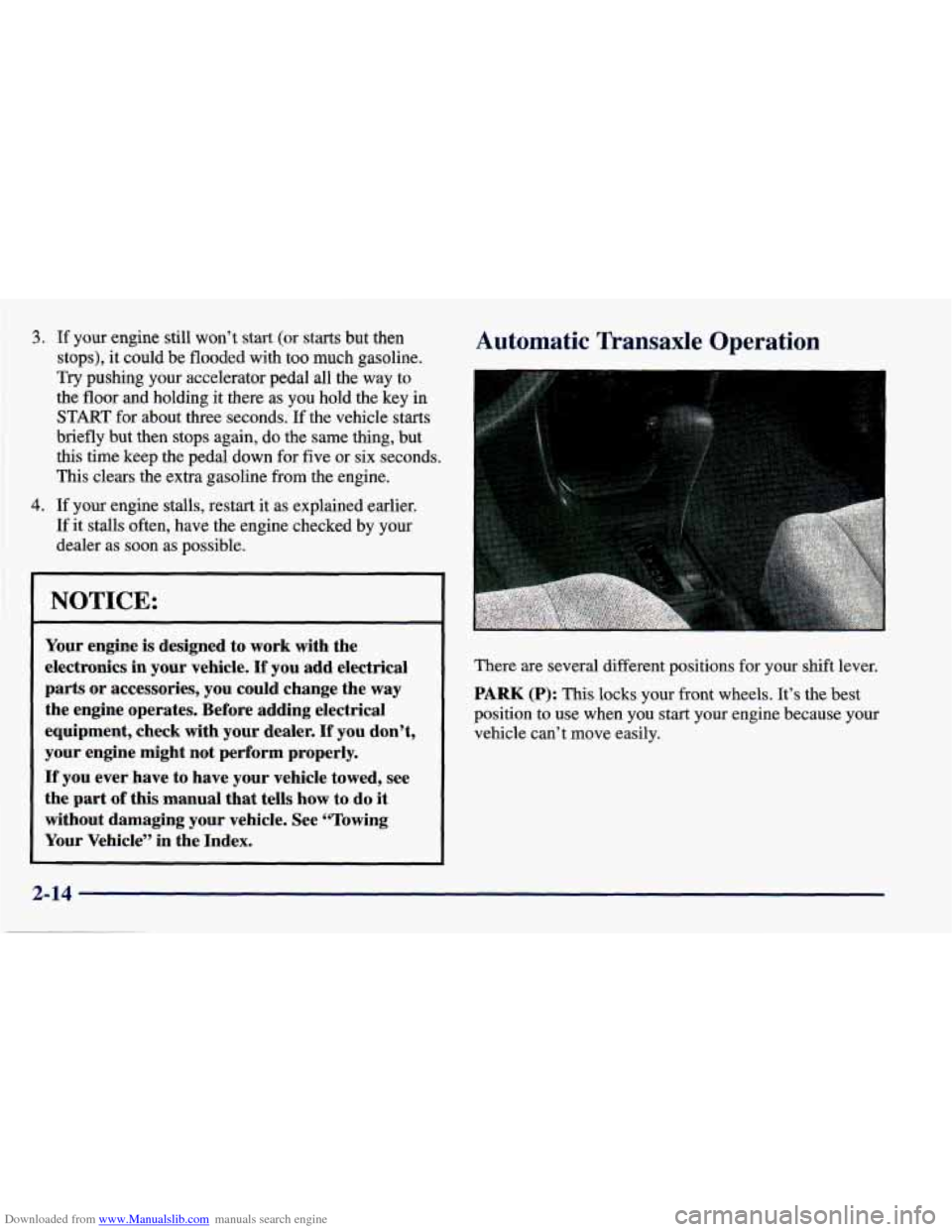
Downloaded from www.Manualslib.com manuals search engine 3. If your engine still won’t start (or starts but then
stops), it could be flooded with too much gasoline.
Try pushing your accelerator pedal all the way to
the floor and holding it there as you hold the key in
START for about three seconds. If the vehicle starts
briefly but then stops again, do the same thing, but
this time keep the pedal down for five or six seconds.
This clears the extra gasoline from the engine.
4. If your engine stalls, restart it as explained earlier.
If it stalls often, have the engine checked by your
dealer as soon as possible.
NOTICE:
Your engine is designed to work with the
electronics in your vehicle.
If you add electrical
parts or accessories, you could change the
way
the engine operates. Before adding electrical
equipment, check with your dealer.
If you don’t,
your engine might not perform properly.
If you ever have to have your vehicle towed, see
the
part of this manual that tells how to do it
without damaging your vehicle. See “Towing
Your Vehicle’’ in the Index.
Automatic Transaxle Operation
There are several different positions for your shift lever.
PARK (P): This locks your front wheels. It’s the best
position to use when
you start your engine because your
vehicle can’t
move easily.
Page 93 of 364
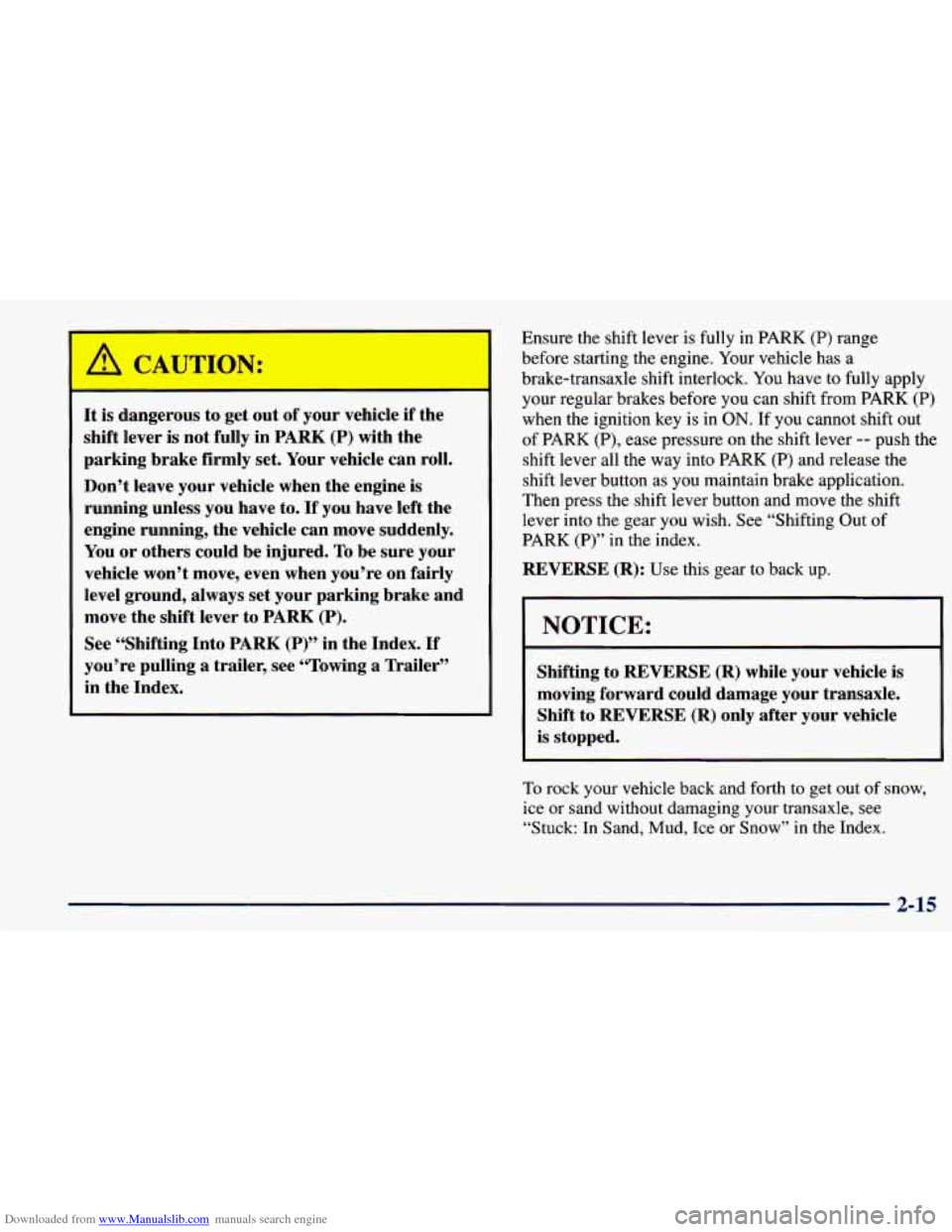
Downloaded from www.Manualslib.com manuals search engine It is dangc- JUS to get out of your vehicle if the
shift lever
is not fully in PARK (P) with the
parking brake firmly set. Your vehicle can roll.
Don’t leave your vehicle when the engine is
running unless you have to.
If you have left the
engine running, the vehicle can move suddenly.
You or others could be injured.
To be sure your
vehicle won’t move, even when you’re
on fairly
level ground, always set your parking brake and
move the shift lever to
PARK (P).
you’re pulling a trailer, see “Towing a Trailer’’
~ See “Shifting Into PARK (P)” in the Index. If
~ in the Index.
Ensure the shift lever is fully in PARK (P) range
before starting the engine. Your vehicle has
a
brake-transaxle shift interlock. You have to fully apply
your regular brakes before you can shift from
PARK (P)
when the ignition key is in ON. If you cannot shift out
of PARK (P), ease pressure on the shift lever -- push the
shift lever all the way into PARK
(P) and release the
shift lever button as you maintain brake application.
Then press the shift lever button and move the shift
lever into the gear you wish. See “Shifting Out of
PARK (P)” in the index.
REVERSE (R): Use this gear to back up.
NOTICE:
Shifting to REVERSE (R) while your vehicle is
moving forward could damage your transaxle.
Shift to
REVERSE (R) only after your vehicle
is stopped.
To rock your vehicle back and forth to get out of snow,
ice or sand without damaging your transaxle, see
“Stuck: In Sand,
Mud, Ice or Snow” in the Index.
2-15
Page 94 of 364
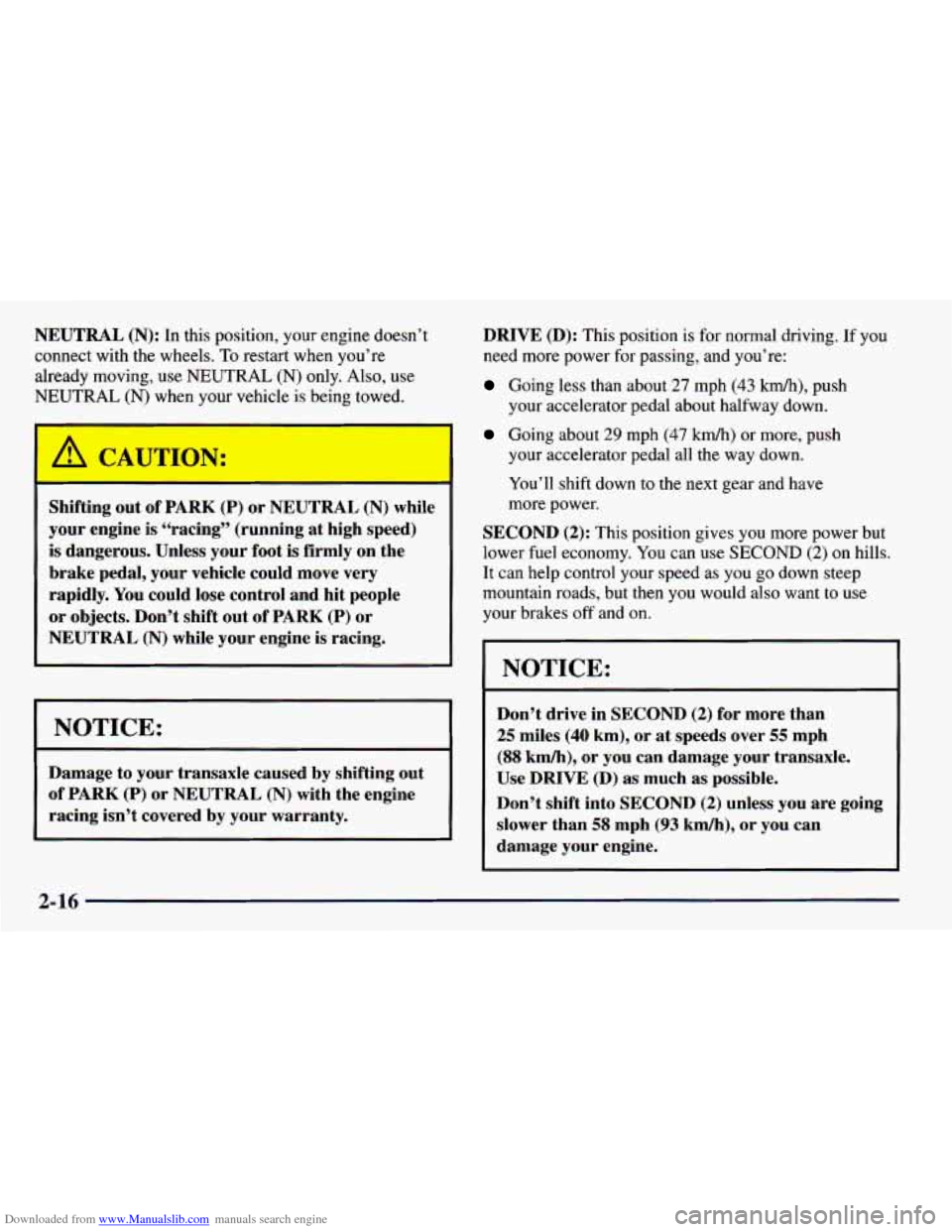
Downloaded from www.Manualslib.com manuals search engine NEUTRAL (N): In this position, your engine doesn’t
connect with the wheels.
To restart when you’re
already moving,
use NEUTRAL (N) only. Also, use
NEUTRAL (N) when your vehicle is being towed.
Shifting out of PARK (P) or NEUTRAL (N) while
your engine is “racing” (running at high speed)
is dangerous. Unless your foot
is firmly on the
brake pedal, your vehicle could move very
rapidly. You could lose control and hit people
or objects. Don’t shift out of PARK (P) or
NEUTRAL
(N) while your engine is racing.
NOTICE:
Damage to your transaxle caused by shifting out
of PARK
(P) or NEUTRAL (N) with the engine
racing isn’t covered by your warrantv. DRIVE (D):
This
position is for normal driving. If you
need more power for passing, and you’re:
Going less than about 27 mph (43 M), push
your accelerator pedal about halfway down.
Going about 29 mph (47 kmh) or more, push
your accelerator pedal all the way down.
You’ll shift down to the
next gear and have
more power.
SECOND (2): This position gives you more power but
lower fuel economy.
You can use SECOND (2) on hills.
It can help control your speed as you go down steep
mountain roads, but then you would also want to use
your brakes
off and on.
-- ~~
NOTICE:
Don’t drive in SECOND (2) for more than
25 miles (40 km), or at speeds over 55 mph
(88 kmh), or you can damage your transaxle.
Use DRIVE (D) as much as possible.
Don’t shift into SECOND
(2) unless you are going
slower than
58 mph (93 km/h), or you can
damage your engine.
2-16
Page 95 of 364
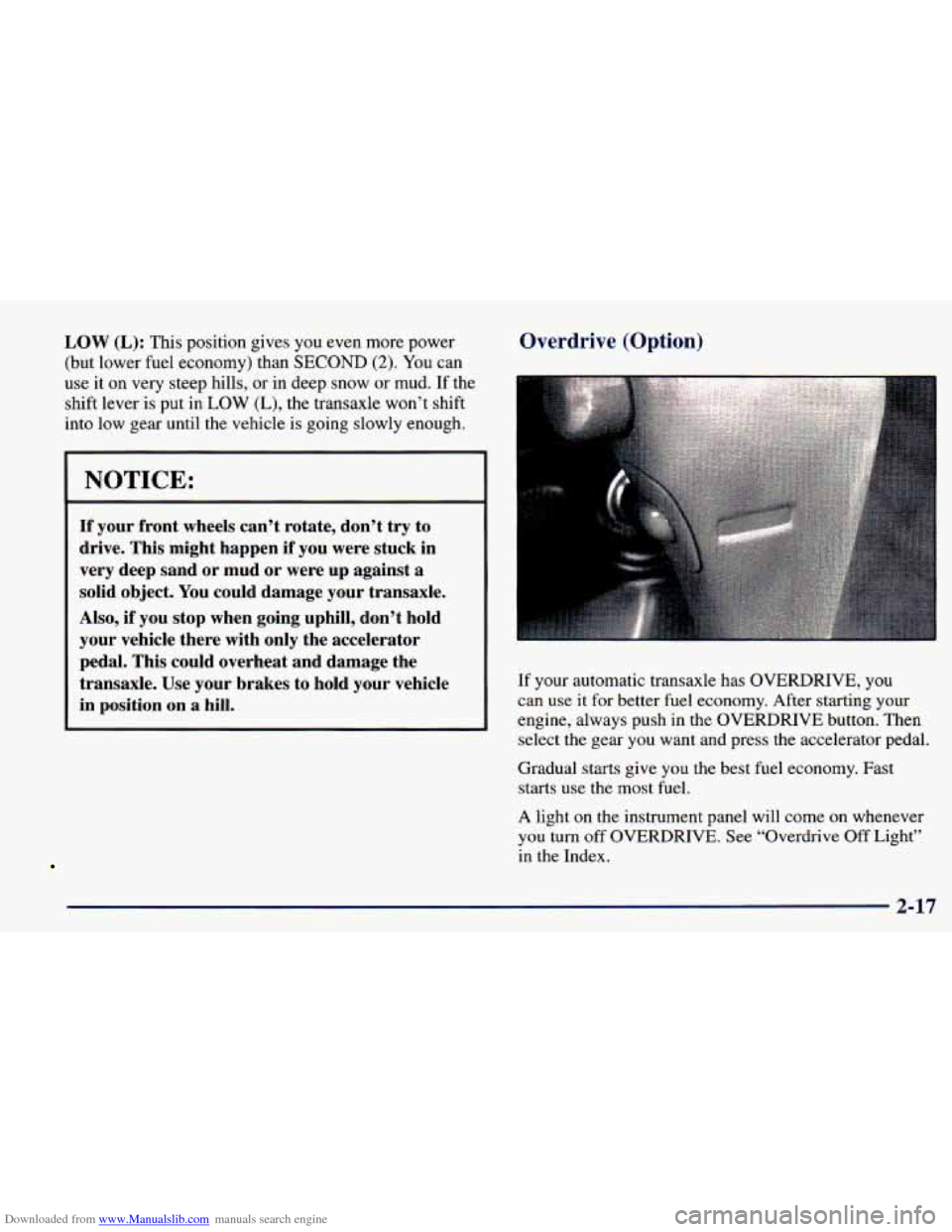
Downloaded from www.Manualslib.com manuals search engine LOW (L): This position gives you even more power
(but lower fuel economy) than SECOND
(2). You can
use it on very steep hills,
or in deep snow or mud. If the
shift lever is put in
LOW (L), the transaxle won’t shift
into low gear until the vehicle is going slowly enough.
I NOTICE.
If your front wheels can’t rotate, don’t try to
drive. This might happen
if you were stuck in
very deep sand or mud or were up against
a
solid object. You could damage your transaxle.
Also, if you stop when going uphill, don’t hold
your vehicle there with only the accelerator
’ pedal. This could overheat and damage the
1 transaxle. Use your brakes to hold your vehicle
~ in position on a hill.
Overdrive (Option)
If your automatic transaxle has OVERDRIVE, you
can use it for better fuel economy. After starting your
engine, always push in the OVERDRIVE button. Then
select the gear you want and press the accelerator pedal.
Gradual starts give you the best fuel economy. Fast
starts use the most fuel.
A light on the instrument panel will come on whenever
you turn
off OVERDRIVE. See “Overdrive Off Light”
in the Index.
2-17
Page 96 of 364
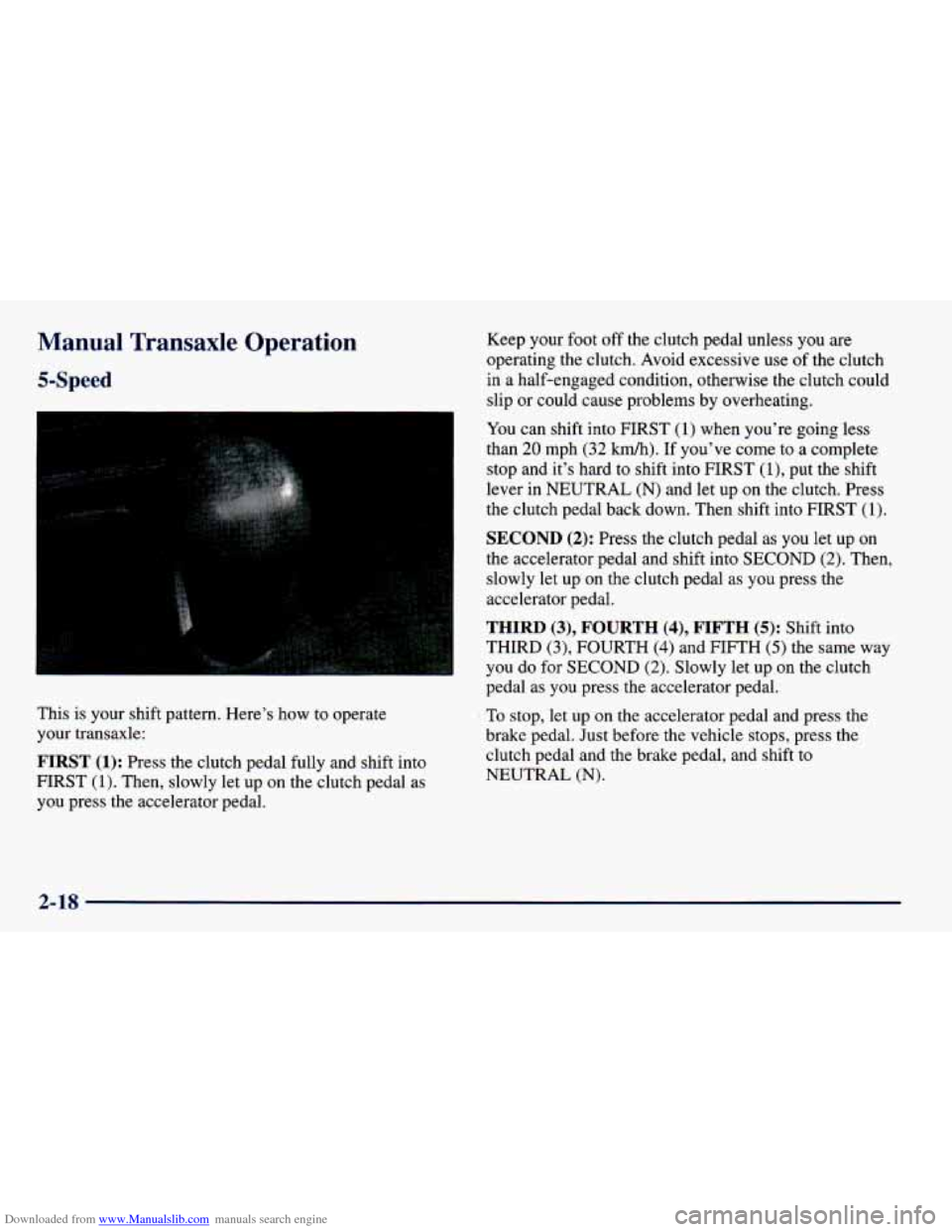
Downloaded from www.Manualslib.com manuals search engine Manual Transaxle Operation
5-Speed
I
This is your shift pattern. Here’s how to operate
your transaxle:
FIRST (1): Press the clutch pedal fully and shift into
FIRST
(1). Then, slowly let up on the clutch pedal as
you press the accelerator pedal. Keep
your foot off the clutch pedal unless you
are
operating the clutch. Avoid excessive use of the clutch
in a half-engaged condition, otherwise the clutch could
slip or could cause problems by overheating.
You can shift into FIRST (1) when you’re going less
than
20 mph (32 kmk). If you’ve come to a complete
stop and it’s hard to shift into FIRST
(1)’ put the shift
lever in NEUTRAL
(N) and let up on the clutch. Press
the clutch pedal back down. Then shift into FIRST
(1).
SECOND (2): Press the clutch pedal as you let up on
the accelerator pedal and shift into SECOND
(2). Then,
slowly let up on the clutch pedal
as you press the
accelerator pedal.
THIRD (3), FOURTH (4), FIF 3 (5): Shift into
THIRD
(3)’ FOURTH (4) and FIFTH (5) the same way
you do for SECOND (2). Slowly let up on the clutch
pedal as
you press the accelerator pedal.
To stop, let up on the accelerator pedal and press the
brake pedal. Just before the vehicle stops, press the
clutch pedal and the brake pedal, and shift to
NEUTRAL (N).
2-1s
Page 97 of 364
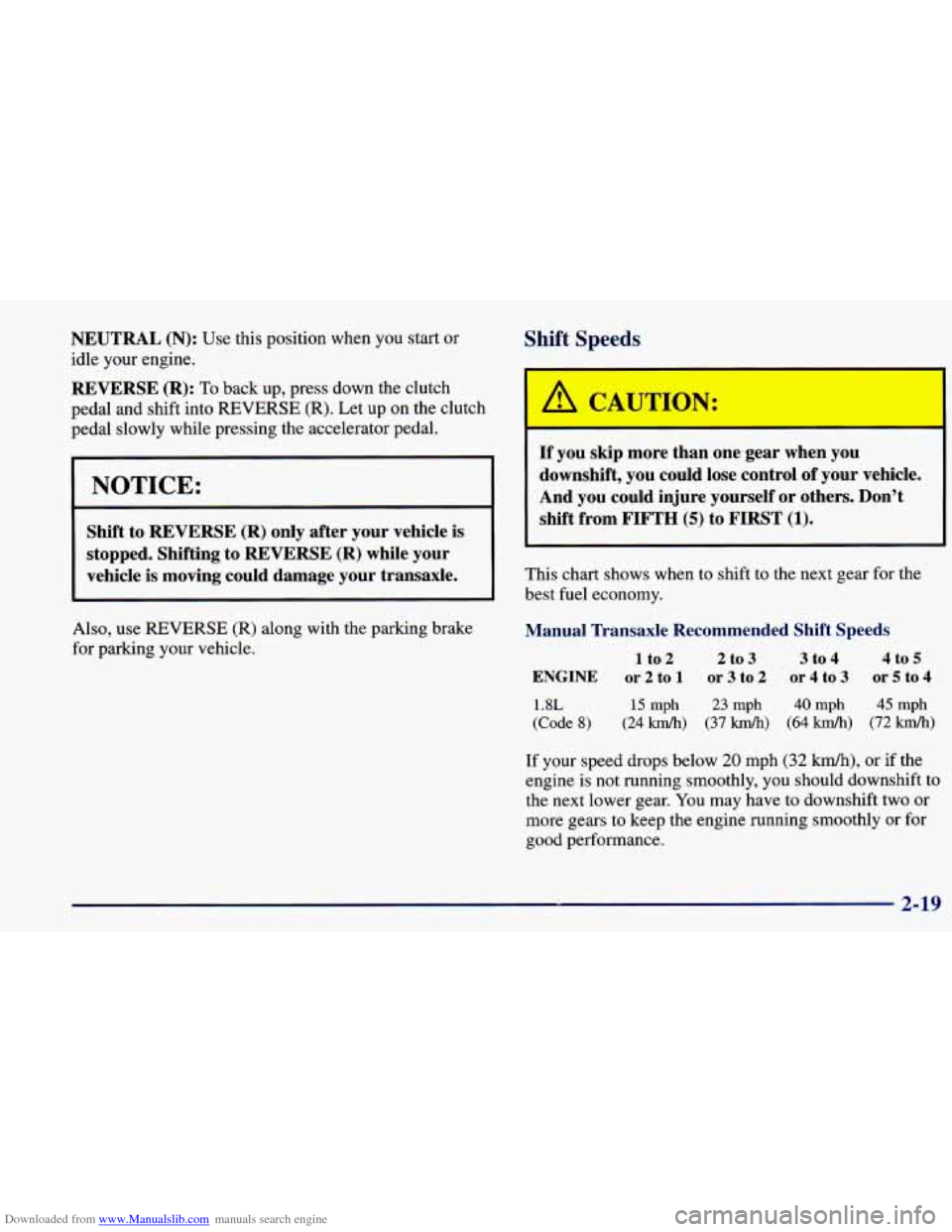
Downloaded from www.Manualslib.com manuals search engine NEUTRAL (N): Use this position when you start or
idle your engine.
REVERSE (R): To back up, press down the clutch
pedal and shift into REVERSE
(R). Let up on the clutch
pedal slowly while pressing the accelerator pedal.
NOTICE:
Shift to REVERSE (R) only after your vehicle is
stopped. Shifting to REVERSE
(R) while your
vehicle is moving could damage your transaxle.
Shift Speeds
Also, use REVERSE (R) along with the parking brake
for parking your vehicle.
-
A CAUTICY:
If you skip more tl n one gear when you
downshift, you could lose control of your vehicle.
And you could injure yourself or others. Don’t
shift from FIFTH
(5) to FIRST (1).
This chart shows when to shift to the next gear for the
best fuel economy.
Manual Transaxle Recommended Shift Speeds
ENGINE
1.8L
(Code 8)
1 to 2 2 to 3 3 to 4 4
to 5
or2to1 or3to2 or4to3
orst04
15 mph 23 mph 40 mph 45 mph
(24 km/h) (37 km/h) (64 kmk) (72 km/h)
If your speed drops below 20 mph (32 km/h), or if the
engine is not running smoothly, you should downshift to
the next lower gear.
You may have to downshift two or
more gears to keep the engine running smoothly or for
good performance.
2-19
Page 98 of 364
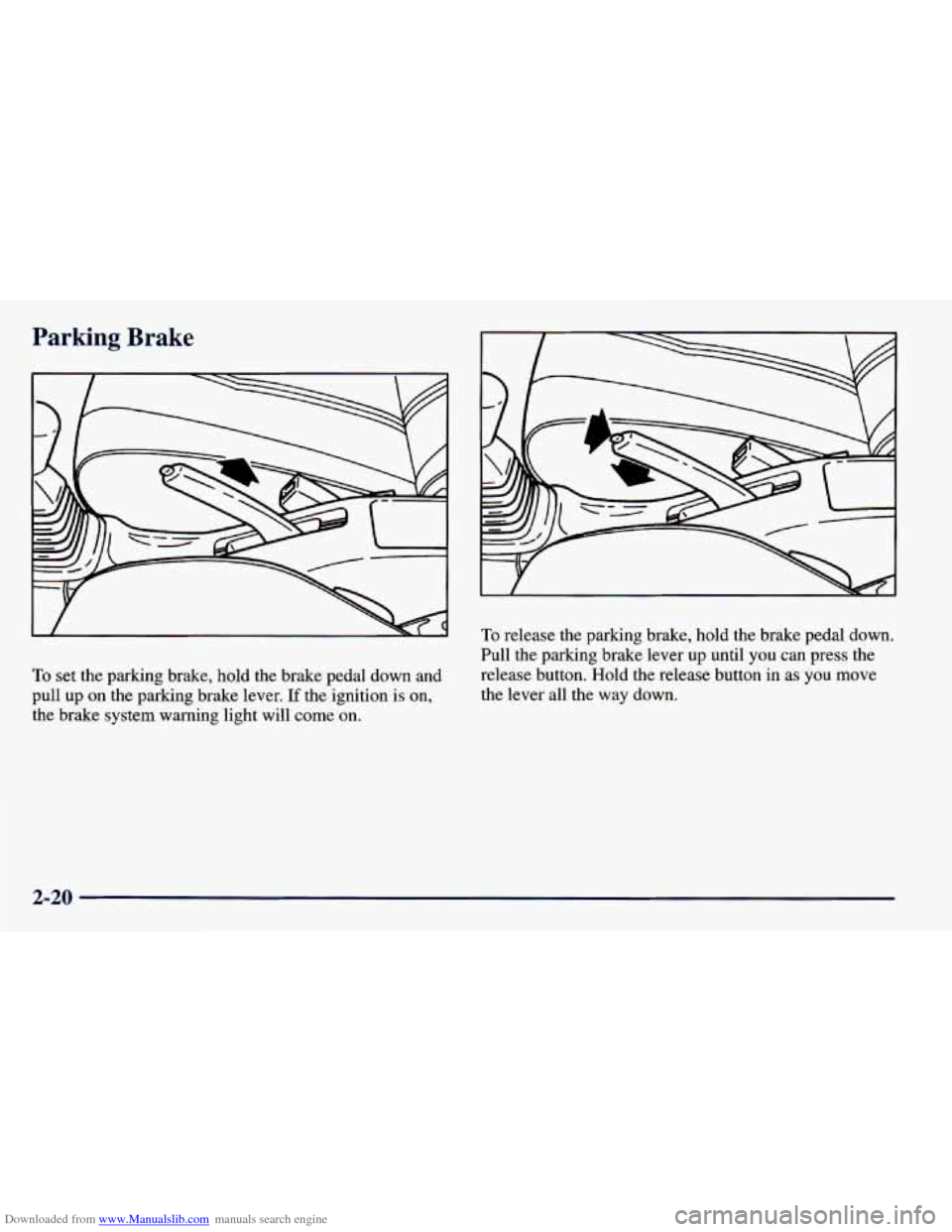
Downloaded from www.Manualslib.com manuals search engine Parking Brake
To set the parking brake, hold the brake pedal down and
pull up
on the parking brake lever. If the ignition is on,
the brake system warning light will
cQme on.
To release the parking brake, hold the brake pedal down.
Pull the parking brake lever up until you can press the
release button. Hold the release button
in as you move
the lever all the way down.
2-20
Page 99 of 364
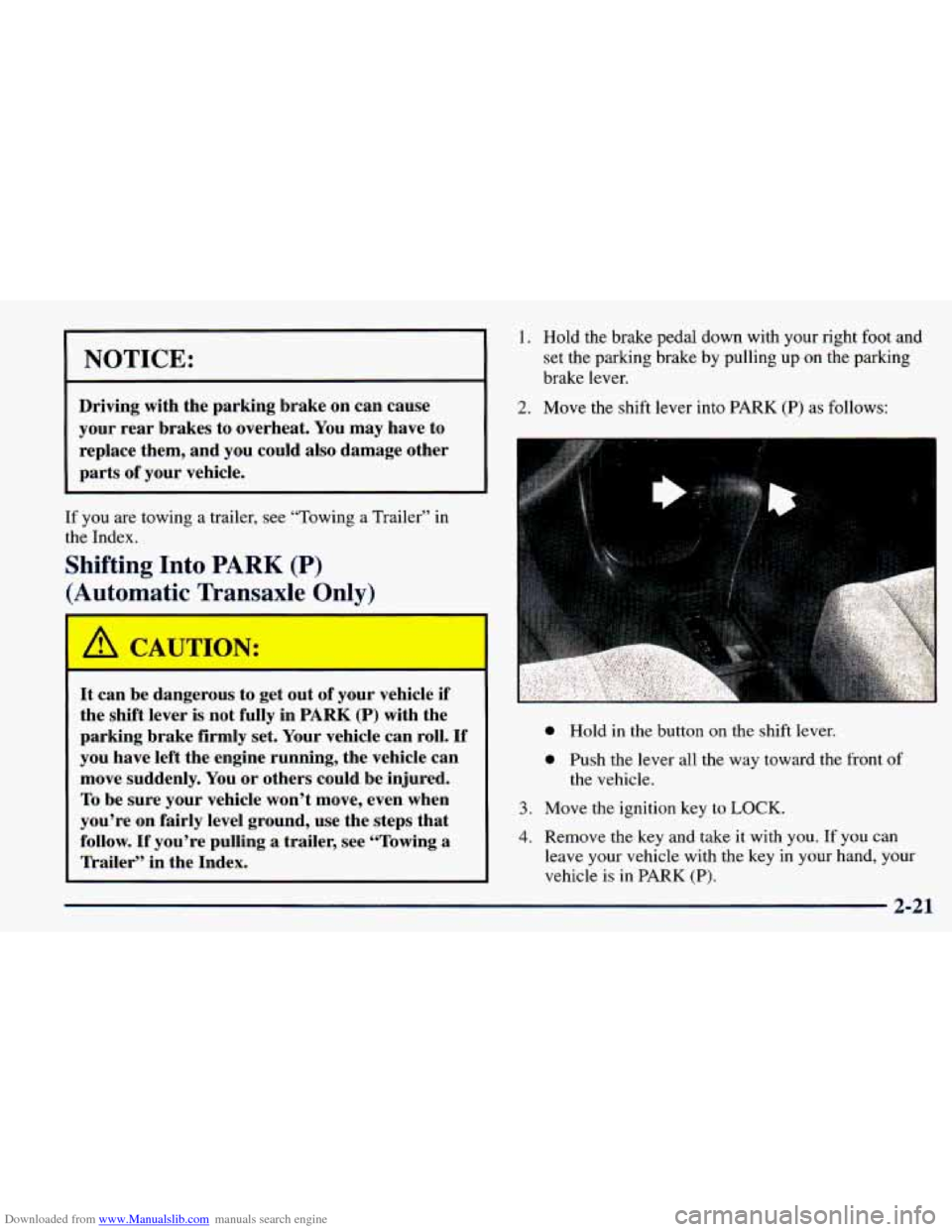
Downloaded from www.Manualslib.com manuals search engine NOTICE:
Driving with the parking brake on can cause
your rear brakes to overheat. You may have to
replace them, and you could also damage other
parts of your vehicle.
If you are towing a trailer, see “Towing a Trailer” in
the Index.
Shifting Into PARK (P)
A
It can be dangerous to get out of your vehicle if
the shift lever is not fully in
PARK (P) with the
parking brake firmly set. Your vehicle can roll.
If
you have left the engine running, the vehicle can
move suddenly. You or others could be injured.
To be sure your vehicle won’t move, even when
you’re on fairly level ground, use the steps that
follow.
If you’re pulling a trailer, see “Towing a
Trailer” in the Index.
1. Hold the brake pedal down with your right foot and
set the parking brake by pulling up on the parking
brake lever.
2. Move the shift lever into PARK (P) as follows:
I
0 Hold in the button on the shift lever.
0 Push the lever all the way toward the front of
the vehicle.
3. Move the ignition key to LOCK.
4.
Remove the key and take it with you. If you can
leave your vehicle with
the key in your hand, your
vehicle is
in PARK (P).
2-21
Page 100 of 364
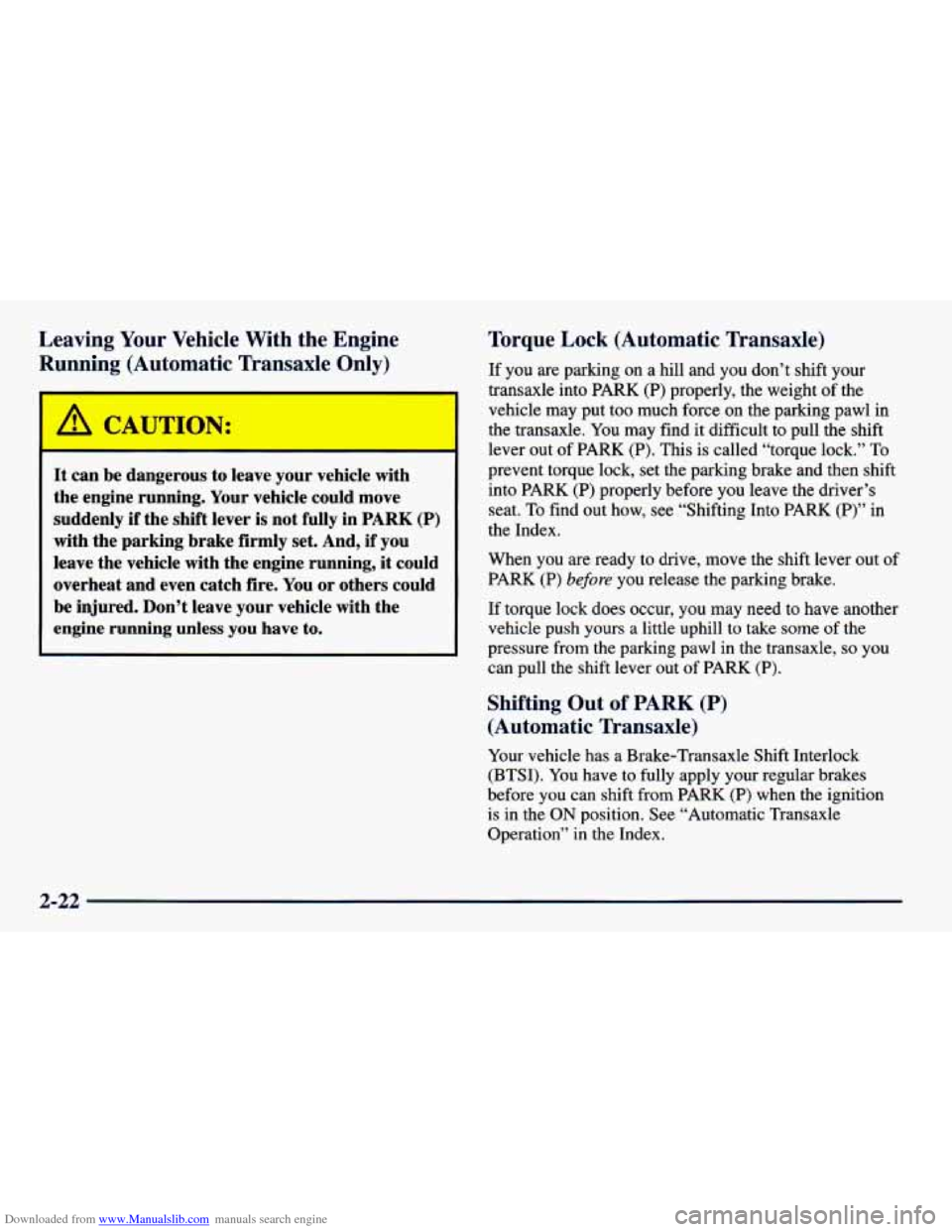
Downloaded from www.Manualslib.com manuals search engine Leaving Your Vehicle With the Engine
RI - - ng (Autom;- ‘ic -‘an - - --’e Only)
It can be dangerous to leave your vehicle with
the engine running. Your vehicle could move
suddenly if the shift lever is not fully in PARK
(P)
with the parking brake firmly set. And, if you
leave the vehicle with the engine running, it could
overheat and even catch fire. You or others could
be injured. Don’t leave your vehicle with the
engine running unless you have to.
Torque Lock (Automatic Transaxle)
If you are parking on a hill and you don’t shift your
transaxle into PARK (P) properly, the weight of the
vehicle may put too much force on the parking pawl in
the transaxle. You may find it difficult to pull the shift
lever out of PARK (P). This is called “torque lock.” To
prevent torque lock, set the parking brake and then shift
into PARK (P) properly before you leave the driver’s
seat. To find out how, see “Shifting Into PARK (P)” in
the Index.
When you are ready to drive, move the shift lever out of
PARK (P)
before you release the parking brake.
If torque lock does occur, you may need to have another
vehicle push yours a little uphill to take some of the
pressure from the parking pawl in the transaxle,
so you
can pull the shift lever out of PARK (P).
Shifting Out of PARK (P)
(Automatic Transaxle)
Your vehicle has a Brake-Transaxle Shift Interlock
(BTSI). You have to fully apply your regular brakes
before you can shift from PARK
(P) when the ignition
is in the
ON position. See “Automatic Transaxle
Operation” in the Index.
2-22